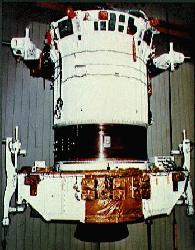Inertial Upper Stage
 The IUS was originally designed as a temporary stand-in for a reusable space tug. The IUS was then named the Interim Upper Stage. The word "Inertial" (signifying the guidance technique) later replaced "Interim" when it was observed that the IUS would be needed through the 1990s.
The IUS was originally designed as a temporary stand-in for a reusable space tug. The IUS was then named the Interim Upper Stage. The word "Inertial" (signifying the guidance technique) later replaced "Interim" when it was observed that the IUS would be needed through the 1990s.
The IUS is a two-stage, solid rocket propelled, three- axis stabilized vehicle for placing spacecraft in a high-Earth orbit or on an escape trajectory for an interplanetary mission. The IUS was developed to carry up to 5,000 pounds to geosynchronous orbit as an integral part of the NASA Space Transportation System and for Titan. It also can boost up to 8,000 pounds out of the Earth's gravitational field to another planet. It is used for NASA and Air Force launches, having flown successfully from both the shuttle and the Titan.
The IUS is 17 feet (5.18 meters) long and 9.25 feet (2.8 meters) in diameter, with an overall weight of approximately 32,500 pounds (14,742 kilograms). The IUS consists of a first stage comprised of a large solid rocket motor containing 21,400 pounds (9,707 kilograms) of propellant and generating approximately 42,000 pounds (188,496 newtons) of thrust and an interstage. The second stage consists of a solid rocket motor with 6,000 pounds (2,722 kilograms) of propellant generating approximately 18,000 pounds (80,784 newtons) of thrust, and an equipment support section.
The large solid rocket motor is the longest thrusting duration solid rocket motor ever developed for space application, with the capability to fire for as long as 150 seconds. Mission requirements determine the thrust level and burn duration of the solid rocket motors. These factors are controlled by tailoring the solid propellant load.
 The equipment support section houses the avionics systems of the IUS. These systems provide guidance, navigation, control, telemetry, command and data management, reaction control and electrical power. All mission-critical components of the avionics system, along with thrust vector
actuators, reaction control thrusters, motor igniter and pyrotechnic stage separation equipment are redundant to assure reliability of better than 98 percent.
The equipment support section houses the avionics systems of the IUS. These systems provide guidance, navigation, control, telemetry, command and data management, reaction control and electrical power. All mission-critical components of the avionics system, along with thrust vector
actuators, reaction control thrusters, motor igniter and pyrotechnic stage separation equipment are redundant to assure reliability of better than 98 percent.
The IUS employs Airborne Support Equipment for installation in the Space Shuttle as well as operation and deployment from the orbiter. The Airborne Support Equipment consists of mechanical, avionics, and structural equipment located in the orbiter. The Airborne Support Equipment structurally attaches the IUS and the payload to the orbiter payload bay, provides interface for the IUS and payload checkout and elevates the IUS/payload for deployment from the Orbiter.
The IUS was developed and built by the Boeing Aerospace Co., Seattle, WA, under contract to the Air Force Material Command's Space and Missile Systems Center. The Space and Missile Systems Center is executive agent for all Department of Defense activities pertaining to the Space Shuttle system and provides the IUS to NASA for Space Shuttle use. For NASA missions, the IUS program is managed by the Marshall Space Flight Center, Huntsville, AL.
IUS Flight History [courtesy Philip Chien] 1982 106A DSCS-2 15 GEO Titan 3 10/30/82 1982 106B DSCS-3 A1 GEO Titan 3 10/30/82 1983 26B TDRS-A GEO STS-6 4/ 4/83 1985 10B DoD GEO STS 51-C 1/24/85 1985 92B DSCS-3 B2 GEO STS 51-J 10/ 3/85 1985 92C DSCS-3 B3 GEO STS 51-J 10/ 3/85 --------- TDRS-B --- STS 51-L 1/28/86 1988 91B TDRS-C GEO STS-26 9/29/88 1989 21B TDRS-D GEO STS-29 3/13/89 1989 33B Magellan planet STS-30 5/ 4/89 1989 46A DSP-14 GEO Titan IV 6/14/89 1989 69A DSCS-2 16 GEO Titan 3 9/ 4/89 1989 69B DSCS-3 A4 GEO Titan 3 9/ 4/89 1989 84B Galileo planet STS-34 10/18/89 1989 90B DoD GEO STS-33 11/23/89 1990 90B Ulysses planet STS-41 10/ 6/90 1990 95A DSP-15 GEO Titan IV 11/12/90 1991 54B TDRS-E GEO STS-43 8/ 2/91 1991 80B DSP-16 GEO STS-44 11/24/91 1993 3B TDRS-F GEO STS-54 1/13/93 1994 84A DSP-17 GEO Titan IV 12/22/94 1995 35B TDRS-G GEO STS-70 7/13/95 1997 8A DSP-18 GEO Titan IV 2/28/97
The STS-38 payload (1990 97A) has been mentioned as having possibly used an IUS, though subsequent analysis has discounted this possibility. The payload was spotted as a spinner, it remained near the shuttle far longer than any IUS has, and a high level industry source swore that it wasn't an IUS. In addition the DSP-15 launch took place just three days earlier, which would have strained the ground support and flight teams to process two stages simultaneously.
Other Resources
- Inertial Upper Stage by Boeing
- Titan IV Inertial Upper Stage
- FY98 Budget 0305138F Upper Stage Space Vehicles (Space)
|
NEWSLETTER
|
| Join the GlobalSecurity.org mailing list |
|
|
|

